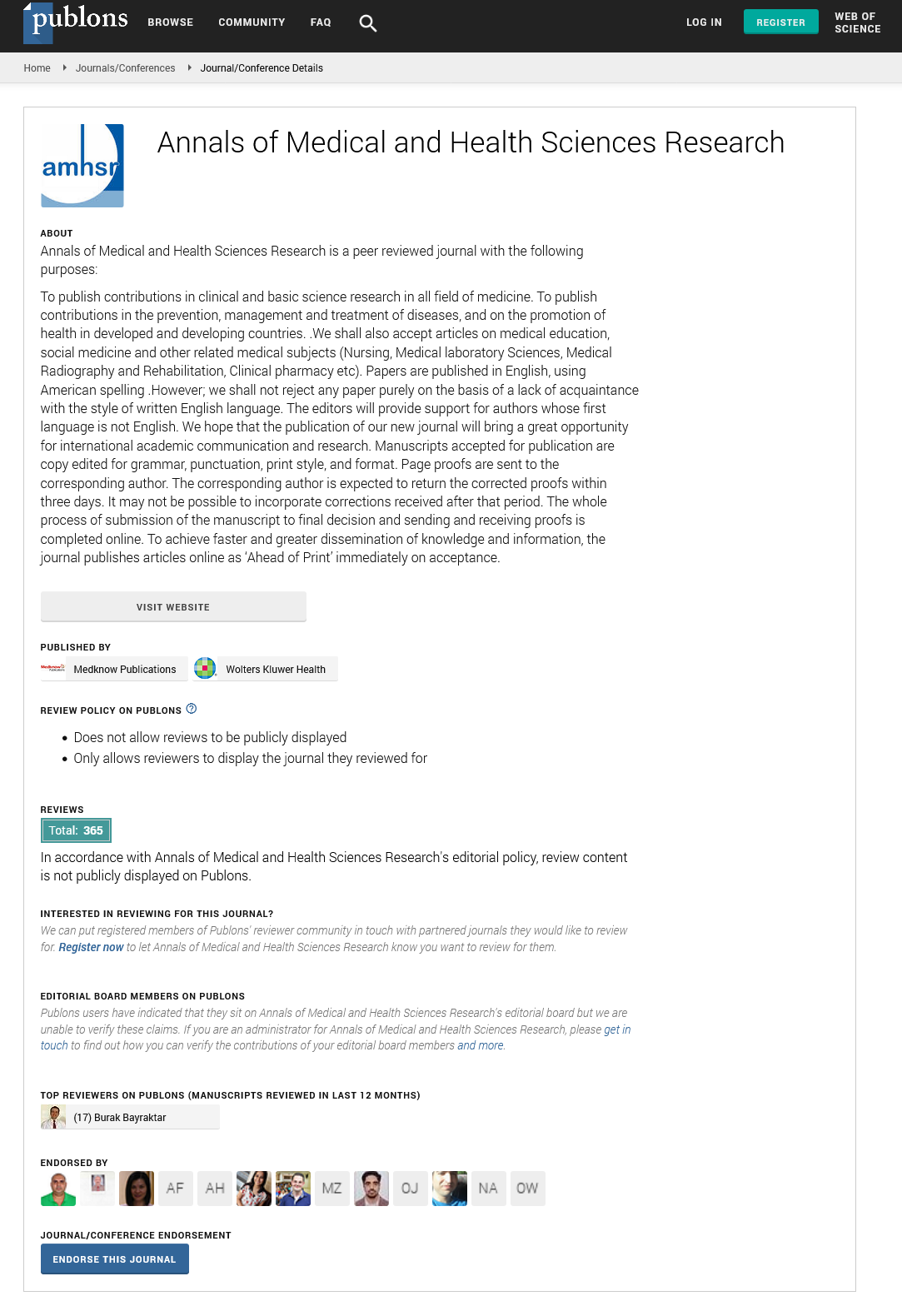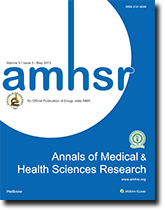Association of Genetic Variants of Hemostasis System Genes with Gestational Thrombophilia in Women
2 Department of Health, Scientific and Practical Center for Specialized Medical Care for children named after V.F. Voyno-Yasenetsky, Mosсow, Russia, Email: PZPO@mail.ru
Received: 18-Nov-2024, Manuscript No. amhsr-24-155435 ; Editor assigned: 20-Nov-2024, Pre QC No. amhsr-24-155435 (PQ); Reviewed: 04-Dec-2024 QC No. amhsr-24-155435 ; Revised: 11-Dec-2024, Manuscript No. amhsr-24-155435 (R); Published: 18-Dec-2024
Citation: Perevezentsev O A. Association of Genetic Variants of Hemostasis System Genes with Gestational Thrombophilia in Women. Ann Med Health Sci Res. 2024;S5: 1-3.
This open-access article is distributed under the terms of the Creative Commons Attribution Non-Commercial License (CC BY-NC) (http://creativecommons.org/licenses/by-nc/4.0/), which permits reuse, distribution and reproduction of the article, provided that the original work is properly cited and the reuse is restricted to noncommercial purposes. For commercial reuse, contact reprints@pulsus.com
Abstract
Background: Venous thrombosis is etiopathogenetically associated with hereditary and acquired conditions characterized by an excessive tendency of the body to thrombosis in blood vessels. One of the types of disorders in the hemostasis system is gestational thrombophilia, which can lead to various pregnancy complications. Therefore, it is important to understand the etiopathogenesis of this pathological condition, including the contribution of hereditary factors.
Objective: To analyze the association of 8 genetic variants of the hemostasis system genes in women with Gestational Thrombophilia (GT).
Design and methods: The study included 311 women aged 20 years to 38 years, who have had at least one pregnancy end in miscarriage and 225 women in the control group. The study of the genotypes of the selected genetic variants was carried out by real-time Polymerase Chain Reaction (PCR) with melting curve analysis.
Results: A positive association was found for 4 genetic variants: F2: 20210 G>A (OR=11.03, CI: 2.60–46.81, P<0.001); F5 1691G>A (OR=6.02, CI: 2.52–14.38, P<0.001); FGB: -455 G>A (OR=5.65, CI: 3.05–10.45, P<0.001) and PAI-1-675 5G>4G (OR=2.28, CI: 1.54-3.39, P<0.001).
Conclusion: Thus, we established an association of 4 genetic variants of plasma hemostatic factor genes with GT in women.
Keywords
Thrombophilia; Gestation; Hemostasis; Hereditary; Miscarriage
Introduction
Venous thrombosis is etiopathogenetically associated with hereditary and acquired conditions characterized by an excessive tendency of the body to form blood clots in blood vessels [1]. Diseases that are somehow associated with coagulation disorders in the vascular bed (myocardial infarctions, strokes, atherosclerosis, hypertension) account for up to 65% of all pathological forms [2-4]. Thrombophilic conditions can occur as an independent pathological process or as a comorbid reaction to a number of diseases [1]. Venous thrombosis is a typical multifactorial pathology, in the etiopathogenesis of which both external and genetic factors play a role [1,5]. Recently, the association of genetic variants with the so-called Gestational Thrombophilia (GT), which occurs in women during pregnancy, has been actively studied [6]. It has been shown that the development of coagulation disorders during gestation can disrupt the uteroplacental blood flow and lead to miscarriage, i.e., it is associated with a complicated obstetric and gynecological history [6,7]. Antiphospholipid Syndrome (APS) also plays a major role in the etiopathogenesis of thrombophilia [7,8]. Antiphospholipid syndrome is a pathological condition that includes certain clinical signs and laboratory changes such as the presence of antiphospholipid antibodies in combination with arterial and venous thrombosis, fetal loss syndrome, immune thrombocytopenia and/or neurological disorders [8]. Thus, APS and coagulation disorders during pregnancy are associated with Pregnancy Loss (PL). Therefore, timely diagnosis of hemostasis disorders during pregnancy, including the identification of a hereditary predisposition to this condition, followed by adequate anticoagulant therapy in 98% of cases leads to normal pregnancy [9,10].
Aim of the work
To analyze the association of 8 genetic variants (F2 20210G>A, F5 1691G>A, F7 10976G>A, F13 G>T, ITGA2 807C>T, ITGB3 1565 T>C, PAI-1 -675 5G>4G) of hemostasis system genes with gestational thrombophilia in women with PL.
Materials and Methods
The study was conducted at the Department of Personalized and Translational Medicine of the Rostov State Medical University. The sample of women included 311 women aged 20 years to 38 years (average age 27 years), who had at least 1 pregnancy with a complicated obstetric and gynecological history and episodes of venous thrombosis during pregnancy. The features of the obstetric and gynecological anamnesis are presented in Table 1. The exclusion criteria were the absence of Pregnancy Loss (PL) against the background of GT, the presence of confirmed monogenic hereditary diseases associated with blood clotting disorders, heart and vascular defects, as well as confirmed certain common diseases (ischemic heart disease, atherosclerosis (according to ultrasound data and an atherogenic index below 3.0), diabetes mellitus types 1 and 2, severe arterial hypertension, obesity, a number of endocrinological diseases (cushing's syndrome, metabolic syndrome, adrenal and thyroid pathology). Women who were diagnosed with preeclampsia syndrome during the gestational periods were also excluded. The control group included 225 healthy women aged 22 years to 39 years (mean age 29 years) without OAG. Deoxyribonucleic acid (DNA) was isolated from peripheral blood using the proba-rapid-genetics kit (DNA technology). Molecular genetic study of genetic variants (F2 20210G>A, F5 1691G>A, F7 10976G>A, F13 G>T, ITGA2 807C>T, ITGB3 1565 T>C, PAI- 1-675 5G>4G) was carried out by real-time PCR with melting curve analysis using the cardiogenetics thrombophilia kit (“DNA Technology”) on a detection amplifier with 4 DTprime detection channels. Registration and accounting of PCR results was carried out automatically by the software for this amplifier. To analyze the association of certain genetic variants with venous thrombosis, four-field distribution tables were used with the calculation of the Odds Ratio (OR) as an association criterion with the calculation of the Confidence Interval (CI). The standard level of P=0.05 (5%) was chosen as the threshold for the significance level. Statistical analysis was performed using STATISTICA 10.0 software.
| Type of PL | Quantity |
|---|---|
| Premature Birth Facts | 78 |
| Antenatal fetal death | 43 |
| Late-term miscarriages | 68 |
| Regressions and miscarriages in early pregnancy | 17 |
| Risk of termination of the last pregnancy | 105 |
Table 1: Features of the obstetric and gynecological history of women with PL
Results and Discussion
According to the results of the association analysis of individual genetic variants with PL in women, a positive result was obtained for the genetic variants F2: 20210 G>A, F5: 1691 G>A, FGB: -455 G>A and PAI-1-675 5G>4G.
The absolute and relative frequencies of the allelic distribution of the genetic variant F2: 20210 G>A of the prothrombin gene are given in Table 2.
| Genotype | GG (%) | GA (%) | AA (%) | Summary |
| Case | 283 (91.0) | 26 (8.4) | 2 (0.6) | 311 |
| Control | 223 (99.2) | 2 (0.8) | 0 (0.0) | 225 |
Table 2: Frequency distribution of genotypes for the genetic variant F2: 20210 G>A of the prothrombin gene in a sample of women with a history of PL and in a control sample.
We also analyzed the frequencies of the GG and GA+AA genotypes in the study sample and in the comparison group. For the sum of the AA+GA genotypes, the OR was 11.03 (CI: 2.60– 46.81, P<0.001). For the frequent GG genotype, the OR=0.09 (CI: 0.02–0.39, P<0.001). Our data show that this genetic variant of the prothrombin gene shows a strong association with PL in women. This is consistent with the literature, which also shows a positive association of the F2: 20210 G>A prothrombin gene with recurrent PL [11-13].
Absolute and relative frequencies of the allelic distribution of the genetic variant F5: 1691 G>A (Leiden variant) are given in Table 3.
| Genotype | GG (%) | GA (%) | AA (%) | Summary |
| Case | 267 (85.9) | 42 (13.5) | 2 (0.6) | 311 |
| Control | 219 (97.4) | 5 (2.2) | 1 (0.4) | 225 |
Table 3: Frequency distribution of genotypes for the genetic variant F5: 1691 G>A of the proaccelerin gene in a sample of women with PL and in a control sample.
We analyzed the frequencies of the GG and GA+AA genotypes in the study sample and in the comparison group. For the sum of the AA+GA genotypes, the OR was 6.02 (CI: 2.52–14.38, P<0.001). For the frequent GG genotype, the OR=0.17 (CI: 0.07–0.40, P<0.001). Our analysis shows that the sum of the heterozygous and rare homozygous genotypes also shows a high association with PL in women, and the frequent GG genotype has a pronounced protective effect. This is also consistent with the literature data [13,14]. The OR value for the Leiden variant varies widely, which may be due to different characteristics of the cohorts in other studies, in particular, ethnic and age [14].
Absolute and relative frequencies of the allelic distribution of the genetic variant FGB: -455 G>A of the fibrinogen gene are shown in Table 4.
| Genotype | GG (%) | GA (%) | AA (%) | Summary |
| Case | 142 (45.7) | 89 (28.6) | 80 (25.7) | 311 |
| Control | 157 (69.8) | 55 (24.4) | 13(5.8) | 225 |
Table 4: Frequency distribution of genotypes for the genetic variant FGB: -455 G>A of the fibrinogen gene in the sample of women with PL and in the control sample.
After analyzing the frequencies of the GG, GA, and AA genotypes in the sample with PL and in the control sample, the following results were obtained: For the rare genotype AA OR=5.65 (CI: 3.05–10.45, P<0.001); for the heterozygous GA OR=1.24 (CI: 0.84–1.83, P>0.283); for the frequent GG OR was 0.36 (CI: 0.25–0.52, P<0.001). From Table 4 it is evident that the rare genotype for this genetic variant shows a high association with PL, while the frequent genotype GG shows a protective effect. Our data are consistent with the works of other authors performed on various ethnic populations [15-17]. An association of the rare A allele with an increased risk of embryo developmental disorders after IVF has also been shown, possibly associated with thrombotic disruption of uteroplacental blood flow [15].
The absolute and relative frequencies of the allelic distribution of the genetic variant PAI-1-675 5G>4G of the plasminogen factor inhibitor gene are shown in Table 5.
| Genotype | 5G/5G (%) | 5G/4G (%) | 4G/4G (%) | Summary |
| Case | 73 (23.5) | 121 (38.9) | 117 (37.6) | 311 |
| Control | 58 (25.3) | 120 (53.8) | 47 (20.9) | 225 |
Table 5: Frequency distribution of genotypes for the genetic variant PAI-1 -675 5G>4G of the plasminogen activator inhibitor gene among women with PL and in the control.
After analyzing the frequency of occurrence of different genotypes in the study and control samples, we obtained the following results: for the homozygous genotype 4G/4G OR=2.28 (CI: 1.54-3.39, P<0.001), for the heterozygous genotype 5G/4G OR=0.56 (CI: 0.39-0.79, P<0.001), for the homozygous genotype 5G/5G OR=0.90 (CI: 0.61-0.35, P>0.620). Thus, the 4G/4G genotype is associated with an increased risk of PL in women with OAGA, while the heterozygous genotype provides a protective effect. In the literature, data on the association of the genetic variant PAI-1-675 5G>4G are quite contradictory. In some studies, the relationship between this variant and OAGA is not shown [18,19]. In a study by Chinese scientists, it was established that in the case of a dominant model of the influence of PAI-1 -675 5G>4G on habitual miscarriage, the risk level is 1.8, which is close to the values obtained in our work [20].
Conclusion
In our study, we established an association of 4 genetic variants of the hemostasis system genes with GT in women. All associated genes belong to plasma coagulation factors. Thus, it can be assumed that these factors play a key role in the etiopathogenesis of PL, therefore, genetic variants F2: 20210 G>A, F5: 1691 G>A, FGB: -455 G>A and PAI-1-675 5G>4G can be recommended for study in women with GT as markers of hereditary predisposition to coagulation disorders during pregnancy.
Ethical committee consent
The study was carried out in accordance with the declaration of Helsinki. The study was approved by the Local Ethics Committee of Rostov State Medical University. Informed consents (Consent to Participate and Consent to Publish) were obtained from all participants or, if participants are under 18, from a parent and/or legal guardian.
References
- Colman RW, Marder VJ, Clowes AW. Hemostasis and Thrombosis. Basic Principles and Clinical Practice. 2006:1827.
- Buller HR, Sohne M, Middeldorp S. Treatment of venous thromboembolism. J Thromb Haemost. 2005;3:1554-1560.
- Wells PS. Integrated strategies for the diagnosis of venous thromboembolism. J Thromb Haemost. 2007;1:41-50.
- Schellong SM. Distal DVT: Worth diagnosing? Yes. J Thromb Haemost. 2007;5:51-54.
- Vasil'yev SA, Vinogradov VL. The role of heredity in the development of thrombosis. Tromboz, gemostazireologiya. 2007;3:32–40.
- Shatalov AE, Petrov YuA. Thrombophilia as a factor in miscarriage. Health and education in the 21st century. 2019:63-67.
- Yarygin DN, Ignatiev SV, Butina EV. Genetic polymorphisms associated with the risk of thrombophilia in women with recurrent miscarriage. Curr Iss Transfus Med & Clin Med. 2015:225-228.
[Crossref]
- Arachchillage DRJ, Laffan M. Pathogenesis and management of antiphospholipid syndrome. Br J Haematol. 2017;178:181-195.
- Skvortsova M Yu. Prevention of reproductive losses and complications of gestation in patients with miscarriage. Media Medica. 2010;12:40-42.
- Peres Wingeyer S, Aranda F, Udry S. Inherited thrombophilia and pregnancy loss. Study of an Argentinian cohort. Med Clin (Barc). 2019;152:249-254.
- Mahmutbegovic E, Marjanovic D, Medjedovic E, Mahmutbegovic N, Dogan S, et al. Prevalence of F5 1691G> A, F2 20210G> A and MTHFR 677C> T polymorphisms in Bosnian women with pregnancy loss. Bosn J Basic Med Sci. 2017;17:309.
- Younis M, Ali MA, Ghareeb DA, Youssef R, Fathy SA. Maternal thrombophilic and hypofibrinolytic genetic variants in idiopathic recurrent pregnancy loss: A continuing mystery. Reprod Sci. 2023;30:656-666.
- Pereza N, Ostojic S, Kapovic M, Peterlin B. Systematic review and meta-analysis of genetic association studies in idiopathic recurrent spontaneous abortion. Fertil Steril. 2017;107:150-159.
- Sergi C, Al Jishi T, Walker M. Factor V Leiden mutation in women with early recurrent pregnancy loss: A meta-analysis and systematic review of the causal association. Arch Gynecol Obstet. 2015;291:671-679.
- Dankova IV, Aleksandrovna MO, Borisovna TT, Anatolyevna PL, Olegovich MD, et al. Genetic and hemostasiological predictors of IVF pregnancy. J Gynaecol Endocrinol. 2017;33(sup1):32-35.
- Jeddi‐Tehrani M, Torabi R, Zarnani AH, Mohammadzadeh A, Arefi S, et al. Analysis of plasminogen activator inhibitor‐1, integrin beta3, beta fibrinogen, and methylenetetrahydrofolate reductase polymorphisms in Iranian women with recurrent pregnancy loss. Am J Reprod Immunol. 2011;66:149-156.
- Goodman CS, Coulam CB, Jeyendran RS, Acosta VA, Roussev R. Which thrombophilic gene mutations are risk factors for recurrent pregnancy loss? Am J Reprod Immunol. 2006;56:230-236.
- Su MT, Lin SH, Chen YC, Kuo PL. Genetic association studies of ACE and PAI-1 genes in women with recurrent pregnancy loss. J Thromb Haemost. 2013;109(01):8-15.
- Cho HY, Park HS, Ahn EH, Ko EJ, Park HW, et al. Association of polymorphisms in Plasminogen Activator Inhibitor-1 (PAI-1), tissue Plasminogen Activator (tPA), and Renin (REN) with recurrent pregnancy loss in korean women. J Pers Med. 2021;11:1378.
- Wen Y, He H, Zhao K. Thrombophilic gene polymorphisms and recurrent pregnancy loss: a systematic review and meta-analysis. J Assist Reprod Genet. 2023;40(7):1533-1558.




 The Annals of Medical and Health Sciences Research is a monthly multidisciplinary medical journal.
The Annals of Medical and Health Sciences Research is a monthly multidisciplinary medical journal.